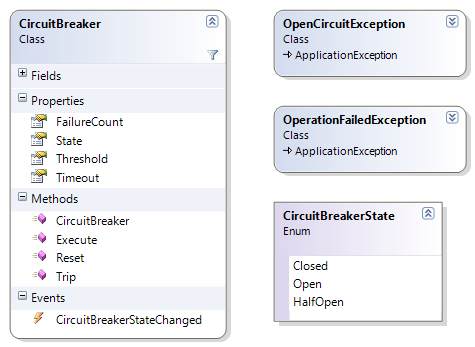In my previous post, I discussed an implementation of The Circuit Breaker Pattern as described in Michael T. Nygard’s book, Release It! Design and Deploy Production-Ready Software. In this post, I will talk about several additions and improvements I have made to the initial implementation.
Service Level
The Circuit Breaker Pattern contains a failure count that keeps track of the number of consecutive exceptions thrown by an operation. When the failure count reaches a threshold, the circuit breaker trips. If an operation succeeds before the failure threshold is reached, the failure count is reset to zero. This works well if the service outage causes multiple consecutive failures, but if the threshold is set to 100 and the service fails 99 times, then one operation succeeds, the failure count is reset to 0, even though there is obviously a problem with the service that should be handled.
To deal with intermittent service failures, I have implemented a “service level” calculation. This indicates the ratio of successful operations to failed operations, expressed as a percentage. For example, if the circuit breaker has a threshold of 100 and an operation fails 50 times, then the current service level is 50%. If the service recovers and 25 operations succeed, then the service level will be 75%. The circuit breaker will not completely reset after a single successful operation. Each successful operation increments the service level, while each failed operation decrements the service level. Once the service level reaches 0%, i.e. the ratio of failed operations over successful ones have reached the threshold, the circuit trips.
A ServiceLevelChanged event allows the client application to be notified of service level changes. This could be used for monitoring performance, or for tracking service levels against a Service Level Agreement (SLA).
The threshold value determines the circuit breaker’s resistance to failures. If a client makes a lot of calls to a service, a higher threshold will allow it more time to recover from failures before tripping. If the client makes fewer calls, but the calls are expensive to the service, a lower threshold will allow the circuit breaker to trip more easily.
Ignored Exception Types
Sometimes a service will throw an exception as part of the service logic. We might not want these exceptions to affect the circuit breaker service level. I have added an IgnoredExceptionTypes property, which holds a list of exception types for the circuit breaker to ignore. If an operation throws one of these exceptions, the exception is thrown back to the caller and is not logged as a failure.
CircuitBreaker cb = new CircuitBreaker(); cb.IgnoredExceptionTypes.Add(typeof(AuthorizationException));
Invoker Exceptions
If the operation invoker throws an exception that was not caused by the operation itself, then the exception is thrown back to the caller and is not logged as a failure.
Threading
As mentioned in a comment by Søren on my last post, it is likely a circuit breaker would be used in a multi-threaded environment, therefore it should be able to function property when multiple threads are executing operations.
The failure count is now updated atomically using the System.Threading.Interlocked.Increment and System.Threading.Interlocked.Decrement methods. This ensures the failure count variable is locked while being modified by a thread. Other threads wanting to update the failure count must wait until it is released.
While this does not guarantee the circuit breaker is completely thread-safe, it does prevent problems with multiple threads executing operations and tracking failures. I have to confess I’m not an expert at multi-threaded application designs, so if anyone has any further suggestions on how to make the circuit breaker more thread-safe, I would love to hear them!
For more information implementing threading, see the .NET Framework Threading Design Guidelines.
Download
Download the circuit breaker code and unit tests (VS 2008).
I hope you find these enhancements helpful. Does providing a service level make sense? How can I improve multi-threading support? If you have any comments or suggestions, please let me know your thoughts.
